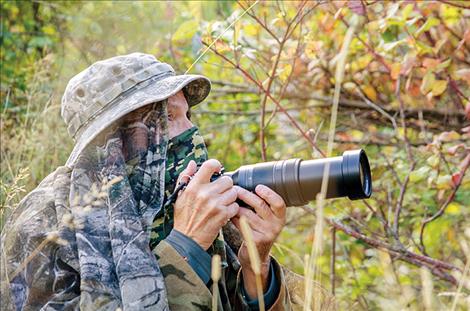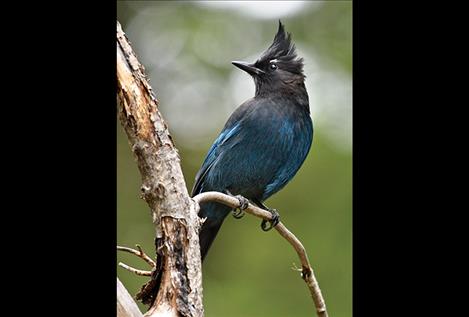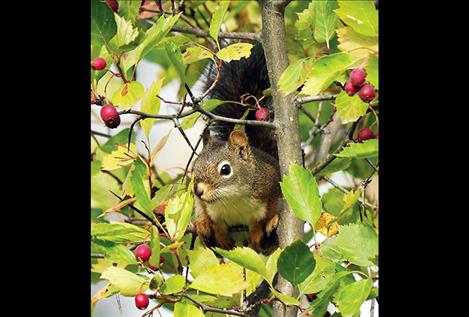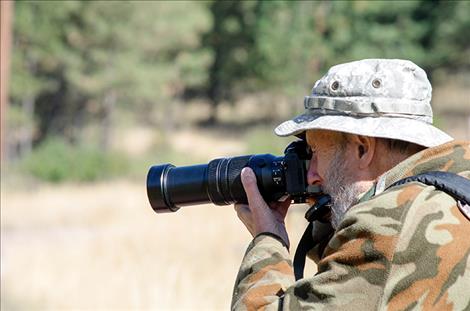A meditation in nature: how one man captures the moment
Hey savvy news reader! Thanks for choosing local.
You are now reading
1 of 3 free articles.
ST. IGNATIUS – Eugene Beckes sits among dense foliage in the morning hours holding his camera, waiting, sometimes for hours, for the moment when a wild bird lands in just the right spot so he can capture its image.
“It doesn’t always work out,” he said. Sometimes a tree limb will be in the way, a bird’s head will be hidden behind a leaf or something else will alter the composition.
But, he said, if you watch closely, through the thick deciduous woods, among the leaves and tall grass, a little bird body could appear, and that is when he slowly brings his camera to his eye and quietly presses the shutter.
His favorite camera to use at the moment is a lightweight Olympus with a 100-400 mm lens. He said this particular lens has a bit longer reach than its numbers indicate.
Beckes takes hundreds of photos on most days, usually of birds, when the lighting is good. He publishes the images in various places including newspapers, calendars and greeting cards with the hopes that someone might see the beauty in nature and want to protect it.
“I want to inspire people to save the world,” he said. “I know it’s a big goal, but it distresses me to see what we have done to this planet.”
He photographs birds and the occasional squirrel picking up nuts and seeds, scampering around on the branches of trees, and doing other various activities while he stays hidden.
He covers himself literally from head to toe in camouflage. His pants are a brown and green cloth with a shirt to match. He wears a homemade mask over the lower half of his face and a hat. And just to make sure the birds won’t see the movement of his eyes and fly away, he covers his head in netting that flows down over his shoulders. Occasionally, a larger creature has wandered by while he is hidden in the Mission mountains causing him to slowly reach for a can of pepper spray.
“I’ve seen a few bears,” he said. “A black bear walked past me once and didn’t seem to care that I was there, thankfully.”
As he watches for birds, he is mindful of their different temperaments. He said that some birds like the belted kingfisher are wary of people while many shore birds won’t fly away when the lens on the camera is moved. The trick, he said, to bird photography is to have a lot of patience and good lighting.
“The morning time is the best,” he said. “The birds haven’t eaten all night and they are hungry, and usually pretty active.”
Beckes said he once stayed in one place for four hours trying to get the perfect photo of a raven, which are one of his favorite birds to photograph, but the time didn’t seem that long.
“Sitting there waiting is like meditating,” he said. “Your mind drifts to other things, but mostly you are focused on the birds.”
While he waits, he notices the sweet smell of blooming mock orange flowers, the natural colors in nature, and the sounds.
“Each bird has a distinctive sound when it flies,” he said. “The Clark’s nutcracker has a different sound than the chickadee.”
He said if he sits really still, like a stump, sometimes a violet-green swallow will fly by and he can hear the sound of air moving by his head, but Beckes isn’t always so patient.
In the wintertime, after bears enter hibernation, he sets up bird feeders in the forested area around his home. He gets a plethora of bird species stopping in for a quick snack including Steller’s jay, Clark’s nutcrackers, ravens, chickadees, and the grey jay.
“I saw a goshawk out there one morning,” he said. “I couldn’t believe it. I thought they only ate what they killed, but there he was, on the suet.”
Beckes also uses the occasional peanut to bring in a bird or a squirrel. He said there are a few theories about feeding the birds in winter including the idea that it messes up the natural order of things, but he feels that a little food is a good thing if it helps them survive a tough season.
He doesn’t consider himself a bird expert, he often asks the experts to help clarify the names of the birds in his photos, but he is concerned with protecting the birds and their habitats, and he supports programs with the same agenda.
He remembers that when he first moved to Montana 45 years ago there were no trumpeter swans. He credits the Confederated Salish and Kootenai Tribes for their work to increase the trumpeter population.
Beckes plans to continue photographing birds and learning about the different species. He said he sometimes gives talks about bird photography to different groups. He plans to share his skills with the Flathead Audubon Society in Kalispell this winter.





















